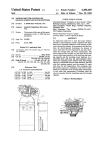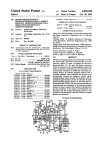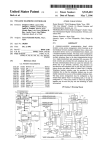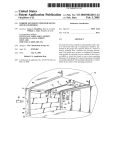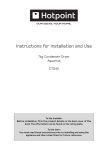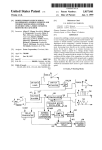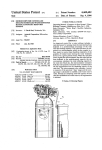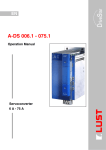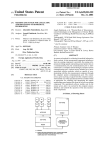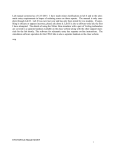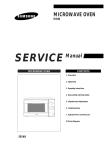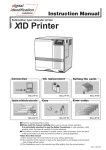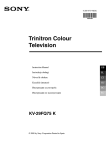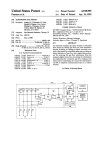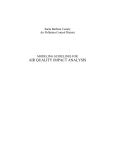Download Water treatment
Transcript
United States Patent [191 [11] Patent Number: 4,470,911 Reinke [45] Date of Patent: Sep. 11, 1984 by Water King, Sta-Rite Industries‘, Publication Date [54] MICROCOMPUTER CONTROLLED’ DEMAND/SCHEDULED WATER SOFI-‘ENER WITH VARIABLE CAPACITY [75] Inventor: [73] Assignee: Unknown. Primary Examiner-Ivars C. Cintins John F. Reinke, Greendale, Wis. Autotrol Corporation, Milwaukee, Attorney, Agent, or Firm-Quarles & Brady Wis. An improved control for a particle bed water treatment device includes a microcomputer which is supplied with input data from a ?owmeter indicative of the quan tity of treated water leaving the water treatment device. [57] [21] Appl. No.: 540,809 [22] Filed: [51] Int. Cl! ...................... ., .................... .. B01J 49/00 Oct. 11, 1983 . ‘ [52] U.S.Cl. .................................... .. 210/662; 210/89; 210/98; 210/140; 210/143; 364/502 [58] Field of Search ............... .. 210/662, 670, 687, 89, 210/98, 102, 103, 109, 140, 143, 190, 191, 269; 364/500, 502 [56] References Cited U.S. PATENT DOCUMENTS 4,104,158 8/1978 ABSTRACT In accordance with the ?ow data, the microcomputer determines the amount of water used since the last re generation and also determines the average daily treated water consumption. The microcomputer is also coupled to a data input device and receives input data indicative of the total particle bed treating capacity resulting in complete particle bed exhaustion. To recog nize and account for the additional particle bed capacity that is created when a partially exhausted particle bed is Davis ................................ .. 210/662 4,237,538 12/1980 Le Dall . . . . . . . . . .. 364/500 4,275,448 6/1981 Le Dall . . . . . . . . . .. 4,385,357 5/1983 Davis et a]. ....................... .. 364/500 364/500 FOREIGN PATENT DOCUMENTS 1450222 9/1976 United Kingdom . 2031614A 4/1980 United Kingdom . 1599706 10/1981 United Kingdom . regenerated, the microcomputer advantageously ad justs the total treating bed capacity value received from the data input device in accordance with the remaining particle capacity existing prior to regeneration. At a prescribed hour each day, the microcomputer deter mines the remaining particle bed treating capacity in ‘accordance with the difference between the adjusted total capacity and the amount of water used since the last regeneration. The remaining particle bed treating OTHER PUBLICATIONS capacity is compared to the reserve established as a “Comput-A-Save System—Operation and Installation proportion of the average daily consumption of treated Guide” by Water Re?ning Company, Inc., Jul. 1, 1978. Sales Literature-“The Electronic Demand Water Softener with Variable Reserve (The Lindsay Know It water and regeneration is initiated when the reserve is greater than the remaining particle bed treating capac lty. All)” by Lindsay Corp., Publication Date Feb. 1982. Sales Literature—“Water King Solid State 301 & 302” 6 Claims, 9 Drawing Figures U.S. Patent Sep. 11, 1984 Sheet 1 of8 4,470,911 25b 20 U.S. Patent ‘ Sep. 11, 1984 Sheet 2 of8 FIG.2 u 2s“ ' 25'; 25A 251 4,470,911 US, Patent Sep. 11, 1984 TO,FROM CKT. 50 FIG. 4 Sheet 4 of8 4,470,911 US. Patent Sep. 11, 1984 POWER UP Sheet 5 of8 4,470,911 7-00 Y ENTER \ DEFAULT L\ZOZ VALUES r FILL 7 DAYS\’_\ZOA CHECK FLOW ,__ 118 WITH v4 CAP. INPUT FOR TRANSITION Z50 YES Z32 NO INCREMENT FLOW COUNT 'zavxw TOGGLE FLOW L.ED. V INCREMENP POWER LOSS "\z'su, COUNTER OUTPUT J DIGIT | To D'SPLAY l msrr 2 A OTHER 0A1‘: "\ZU ‘ COUNT 2 1 DISPLAY v ERROR Z40 000E OUTPUT CHECK l SEC me "\122 ‘ NO BLANK I J DISPLAY U. Patent Sep. 11, 1984 Sheet 6 of s 4,470911 FROM FIG. 5A RELAD /ZZL° RG58 I SEC COUNTER 27L‘, CONVERT \ PULSES TO GALLONS 21?, p ADD GALLONS\ T0 DAILY TOTAL INCRMENT | HOUR COUNT (2cm RESET HOURS TO I100 298 US. Patent Sep. 11, 1984 4,470,911 Sheet 7 of 8 ZESL V RESTORE DATA FOR DISPLAY CLEAR IO SECONDQw 2%) 230 y r’ SAVE DATA INCREMENT HOURS CLEAR FLASH FLAG Ma#5 Z102. c LEAR ERROR c005 Z‘p BLANK DATA FUR DISPLAY U.S. Patent Sep. 11, 1984 FROM FIG. 58 Sheet 8 of 8 4,470,911 v F|G.5D COMPARE To RESERVE ~ 37-? VALUE ADD ToDAY’s GALLONS To P304 TOTAL BETWEEN REGENERATION T CALCULATE -- 39b 7 DAY AVERAGE AFTER sTART _ SH I FT DATA IN FOR AVG. ‘SAVE TO DAY’S GAL TO COMPARE AGAINST 3 0 AVG. ' N 3% ' ‘ SET READ CAPACITY INPUT Nam ' T T CALCULATE > SURPLUS FACTOR ’\ 3W"? T V CALCULATE sToRE ADDITIONAL J RELAY FLAG LOOK-UP CAPACITY COEFFICIENT 321 SURPLUS FACTOR Nave»: CAPACITY TT ‘325* __ 315',‘ v CALCULATE CLEAR v TOTAL CAPACITY ‘Tub-4 GALLONS -— 51b 5 USED T READ HARDNESS INPUT a CALCULATE VOLUMETRIC T RESET \/3ze>A \ “55 DAY n CAPACITY T SUBTRACT GALLONS USED SO FAR l ~Z~IZO (9” m 1 4,470,911 2 when the resin bed'is partially exhausted or‘ when the‘ bed is totally exhausted. The capacity of the-resin bed MICROCOMPUTER CONTROLLED DEMAND/SCHEDULED WATER SOFI‘ENER WITH VARIABLE CAPACITY remains the same regardless of whether the bed is par tially exhausted or fully exhausted. During a counter-current regeneration, the regener BACKGROUND OF THE INVENTION ant tlows in a direction opposite to that of the service flow and thus enters the resin bed through what was the This invention relates generally to a control unit for a service ?ow outlet and ?rst contacts the unexhausted resin bed type water softener and more particularly to resin. Since theunexhausted resin contains no metallic an improved microcomputer-based control unit for a resin bed water softener which continually monitors the 10 or hardness ions, the regenerant generally remains unaf-_ fected as it ?ows through the unexhausted resin until resin bed capacity and adjusts for the additional capac the regenerant passes into the exhausted resin portion ity created when a partially exhausted resin bed is re where ion exchange does occur, causing the regenera generated with the amount of regenerant normally re tion of the exhausted resin. As a consequence, the re quired by a fully exhausted resin bed. The most common type of water softener is the ion leased hardness ions pass only through the exhausted exchange resin-type softener having a vertically dis resin without further exchange as they are flushed from the resin bed. The counter-?ow of regenerant during posed tank which holds a bed of resin through which the hard water is passed to remove undesirable minerals and other impurities. The capacity of the resin bed to absorb minerals and impurities is ?nite and it is thus necessary to periodically recharge or regenerate the resin bed with a regenerant, typically a brine solution, by causing the brine solution to flow from one end of counter-current regeneration results in aneffectively increased amount of regenerant, as measured in pounds, that is available to regenerate the exhausted resin, as measured in cubic feet, of a partially exhausted resin bed in comparison to a completely exhausted resin bed. This may be seen from the following example. Assuming the amount of regenerant used during each regeneration is‘ the tank to the other so as to restore the capacity of the resin bed for further water treatment. 25 set at 6 pounds of brine (NaCl) solution and the volume The two types of processes commonly employed to of resin in the tank is 1 cubic foot, then, the regenerant regenerate a resin bed water softener are co-current level applied to completely exhausted bed will be given regeneration and counter-current regeneration. Co-cur rent regeneration is accomplished by causing the regen as follows: erant ?uid (brine solution) to flow in the same direction 30 as the normal or service flow of the incoming water 6 lb. Regenerant level = — = 6 lb./ft3 (1) 1 cubic foot through the resin bed. Typically, the service flow is directed downwardly against the resin bed to keep the When the resin bed is only two-thirds exhausted (:1, resin bed compacted. In contrast, counter current re capacity remaining) then, assuming that the regenerant generation is achieved by causing the regenerant fluid 35 only acts upon the exhausted portion of the resin bed, to flow upwardly, at a low velocity, through the resin the regenerant level applied to the exhausted resin will» bed to maintain the resin bed in a compacted mass. As be given by will be understood by those skilledin the art, the down ward and upward flow of regenerant during co-current and counter-current regeneration, respectively, could 40 6 lb. Regenerant level = _ = 9 lb./ft3 (2) § cubic foot be reversed if other means were employed to maintain a compacted resin bed. During the normal or service ?ow of water through the resin bed, the hard water entering the flow inlet Thus, the effective regenerant level applied to the ex tends to ?rst exhaust the resin nearest the inlet so that 45 the resin within the tank tends to stratify into an ex pletely exhausted. hausted section adjacent to the service inlet and an undiminished or unexhausted section adjacent to the service outlet. The unexhausted portion of the resin bed additional resin bed capacity created‘ upon regeneration hausted portion of the resin bed is much greater than the regenerant level applied to the bed where the bed com It is well known to those skilled in the art that the of a partially exhausted resin bed is a function of the regenerant level. For example, the resultant capacity is separated from the exhausted section by a relatively 50 regenerant level relationship for a common resin, such narrow band of resin comprised of a mixture of ex as IONAC type C-253 resin, manufactured by Sybron hausted and unexhausted resin particles. During ,a co Corporation, Birmingham, N.J., is illustrated below in current regeneration, the regenerant, which flows in the Table 1. ' same direction as the service flow, ?rst contacts the exhausted resin causing the metallic or hardness ions 55 that were previously exchanged during the service flow of water, to be released from the resin and replaced with the ions of the regenerant. Before the hardness ions may be flushed from the resin tank, the hardness ions must pass through the unexhausted resin adjacent to the out let. However, as the hardness ions pass through the unexhausted resin, the hardness or metallic ions are exchanged with the unexhausted resin as occurs nor TABLE I Regenerant level (lb. of NaCl/cubic feet) 6 9 12 15 Capacity (grains of CaCO3/cubic foot) ' ‘ 20.000 27,500 30,000 31,500 As may be appreciated from examination of Table I, the capacity does not increase in direct proportion to the mally during the softening process. Thus, the previ ously unexhausted resin becomes exhausted. Therefore, 65 regenerant level. Using the capacity data set forth in Table I, the in the regenerant ?uid contacts only the exhausted resin as crease in capacity for the previous example may be it flows toward the outlet and, as a result, there is no calculated in the following manner. If the one cubic difference during a co-current regeneration between 4,470,91 1 3 4 microcomputer to control water softener resin bed re~ foot resin bed is completely exhausted, and the regener ant level is 6 lbs./ft.3, and the resultant capacity will be generation. It is another object of the present invention to pro vide an improved microcomputer-based water softener control unit which controls water softener resin bed given by Resultant Capacity=1 ft,3><20,O0O grains/“3:20.000 grains (3) regeneration in accordance with the remaining capacity of the water softener resin bed to treat water. It is yet another object of the present invention to remains Assuming unexhausted, that E of the capacity resin bed of is the exhausted unexhausted and resin bed, assuming that it had been completely regener provide an improved microcomputer~based water soft 0 ener control unit which initiates water softener resin ated during a previous interval with a regenerant level bed regeneration when the remaining resin bed capacity of 6 lb./ft.3, will be given by as determined from the actual soft water consumption is less than a reserve value calculated in accordance with Resultant Capacity =5 ft.3 X 20,000 (4) grains/ft.3 : 6,666 grains the actual soft water consumption so that regeneration 15 occurs only when necessary, thereby achieving a sav ings of regenerant and water. It is yet another object of the present invention to provide an improved microcomputer-based water soft ener control which recognizes and adjusts for the in creased capacity created when a partly exhausted resin bed is regenerated. The control initiates regeneration The resultant capacity of the exhausted resin, when regenerated with an effective regenerant level of 9 lb./ft.3 as determined previously by Equation (2) will be given as follows Resultant capacitys;z ft.3><27,50O grains/ft,3=18,333 grains based on the additional capacity value so as to achieve (5) an even greater savings of regenerant and water. The total capacity is the sum of the capacity of the BRIEF SUMMARY OF THE INVENTION unexhausted % portion of the bed (6,666 grains) plus the capacity resulting from regeneration of the 3 portion of Briefly, in accordance with the preferred embodi ment of the invention, I have provided a control for a the exhausted bed with a regenerant level of 9 lb./ft3 (18,333 grains) as may be seen from Equation 5 which is water softener requiring periodic resin bed regeneration comprising a ?owmeter for detecting the quantity of softened water leaving the softener. A data input device Total Capacity=6,666 + 18,333 =25,000 grains is also provided for receiving data indicative of the capacity of the resin bed and the hardness of the incom~ ing water. Both the flowmeter and the data input device The capacity increase will be given by Capacity Increase=25,000-20,000=5,000 grains are coupled to a controller which determines the aver 35 age daily consumption of soft water from the ?owmeter As may be appreciated from Equation (6), a 25% capac ity increase is obtained. If the hardness of the incoming water is 20 grains per gallon, then the volumetric in crease in capacity would be given by data. The controller reads the hardness and capacity data and adjusts the capacity data in accordance with the capacity remaining before the previous regeneration to account for the additional capacity that may have 40 been created during the previous regeneration if the resin bed was regenerated when partially exhausted. 5,000 grains Volumetric Increase : 20 grains/gallon The remaining capacity is determined by subtracting = 250 gallons. The foregoing example thus indicates that a significant amount of additional capacity may be obtained merely the quantity of water consumed thus far from the ad 45 justed capacity data. Once the remaining resin bed treating capacity is calculated, the controller deter mines whether or not regeneration should occur by by recognizing the increased capacity resulting from comparing remaining resin bed treating capacity to a regeneration of the exhausted portion of the resin bed reserve value established by the controller in accor dance with the actual average consumption of soft wa with a regenerant level which is effectively greater than that employed to regenerate a completely exhausted bed. > Present day water softener controls, and even the advanced microcomputer-based water softener control disclosed in the now allowed US. patent application ter. If the remaining resin bed treating capacity is less than the established reserve value, then regeneration is initiated. In accordance with another aspect of this invention, I have provided an improved method for controlling Ser. No. 412,279 now US. Pat. No. 4,426,294 for “Mi 55 water softener resin bed regeneration commencing with crocomputer Controlled Demand/Scheduled Water Softener“ filed by J. David Seal on Aug. 27, 1982, and assigned to the assignee of the present invention, do not recognize and evaluate the additional capacity resulting from regeneration of the exhausted portion of the resin bed with the increased regenerant level. If a control could recognize and evaluate the additional capacity, then the number of regenerations would be reduced without increasing the possibility of delivering unsoft the steps of measuring the quantity of water leaving the softener over a given period of time and then determin ing the actual daily average quantity of soft water con sumed and the amount of soft water used since the last regeneration in accordance with the measured amounts of soft water leaving the softener. Thereafter, a reserve quantity of soft water is established from the calculated daily average of soft water consumption. The remaining water softener resin bed treating capacity is calculated ened water. By reducing the number of regenerations, a savings of regenerant and water would be effected. It is an object of the present invention to provide an by subtracting the quantity of water consumed from a total capacity value which is calculated by ?rst deter improved water softener control unit which utilizes a dance with the water hardness and then adjusting the mining the original resin bed treating capacity in accor 4,470,91 1 5 value. , ‘ 6 and a capacity icoef?c‘ient,‘representing ‘the increased capacity attributed to regeneration with an effectively capacity value to account for the additional capacity that resulted if the resin bed had been regenerated when partially exhausted. Water softener resin bed regenera tion is effected when the remaining watersoftener resin bed‘treating capacity is less than the established reserve greater regenerant level.’ In practice, ‘the capacity coef ?cient is obtained from a look up table in accordance with the previously calculated surplus value. The ca pacity coefficient table values are obtained empirically, V based on the‘ type of 'resin‘and anticipated‘ water condi In operation of my improved control, data from the flowmeter is monitored by the microcomputer and at a tions. particular time each day, as determined by the clock, ' ~ ’ " » BRIEF‘DESCRIPTION OF ‘DRAWINGS data representing the actual amount of soft water used during the previous 24 hour period is stored in the mem ory. Typically, seven consecutive values representing The‘invention, vboth as to organizationiand method of operation, together with further objects and advantages the actual daily soft water usage for each of the previ ous‘seven days are stored in themer'nory. After storing ‘thereof-may best kbeaundersto‘odqby reference to the following descriptiontaken'in conjunction with the the soft water consumption data, ‘the microcomputer .;accompanying drawings inwhich: I the control-of the present invention; I I. . FIG. 2 is a side view of the control of- the water and then determines the actual average daily soft water used by averaging the stored data representing actual soft water .usage. § Following calculation of the total . I FIG. 1 is aresin Ibed type water softener» ‘embodying ?rst calculates the total amount'of soft water used since the last regeneration from the data ‘stored in memory softener ‘illustrated in'FIG. 1; 20 . .p FIG. ‘3 is a‘ front view of the control of the water amount of soft water used since the last regeneration, softener illustrated in FIG. 1; I1 the microcomputer then calculates the remaining resin bed capacity by‘ subtracting the amount of ‘resin bed FIG. .4 is‘ an electrical schematic diagram of the cir cuitry embodied in the vcontrol of. the water softener ~ ~ ~ » v . capacity depleted, as determined from the total amount of soft water used since the last regeneration, from an illustrated FIG."4a in is ~FIG;=’1;' a cut awayivi‘ew'of and ‘I * the water '- s softener of adjusted'capacity value. The adjusted capacity value is FIGII taken along‘lines'4a~'—4a; \ calculated by first reading the input capacity data, rep resenting the total capacity of thewater'softener prior to complete resin bed ‘exhaustion and then adding a value representing'the additional capacity that resulted‘ ‘ i‘ ' 35 I DETAILED DESCRIPTION “OF THE ‘ PREFERRED EMBODIMENT serve value established by the microcomputer as a pro I . the present invention during operation. ‘ i 30 softener capacity, this value is thenc‘ompared to a re waterusagé. . the program executed by the wateris‘oftener control of when‘ the resin bed was regenerated when only partially exhausted. Having now calculated the remaining [water portion‘of the determined‘actual average daily soft r FIGS. ‘SA‘through 5D illustrate, in ?owchart form, ‘ ‘Referring now 'to the Figures," FIG. l-illustrates a jresin‘bed type "water softener ‘10 whichincludesa tank 12 containing a resin bed: 14'. ‘As incoming hard water ‘ enters the tank'throu'gh an openingtnotl‘shoiwn) in the I‘ “ Typically, the reserve is ‘calculated by multiplying the actual average daily soft water usage by 1.2.’ If the l to'p‘th'er'eof, the water in the tank is ‘forced throughthe reserve is greater than the calculated remaining water ‘softener, capacity, then water, softener rege‘neration'is _"the center offthe‘resinibed so that water exiting via the resin ‘bed and out the" draw ‘pipe 16-extending through 40 :draw pipe has been treated‘by'the resin bedto remove initiated. Otherwise, the microcomputervonly updates 'fi‘minerals and other impurities. The capacity of resin bed the data, received. from the flowmeter‘and ‘waits another 24 hours before repeating these ‘calculations to'deter mine whether or ‘riot‘regenerationshoul'd occur. vFurthermore, another advantage of the water soft ener control of the present‘invention is that the control can account for'exceptional variations in soft water usage. If the usage during any one of the previous seven 14 to ab‘sorbith'e minerals and impurities ofthe. incoming hard water is ?nite, and depends on the treating capac» ,_ity' of th'e7resininfthe tank ‘as measured inIkilograins. of ‘hardness as 'i'iwelli asl'thethardness 'of the incoming water as‘ typically'measured ‘in ‘grains per gallon. ‘To regener ‘fate the"i'esinibed;->once its (treat-h1g1 capacity has been depleted, the resin bed is ?ushed witha brine solution so that’ the minerals and other iirnpurities‘can be‘released days is less than 20% of the calculated average, then from the resin bed and carried out-the tank.’ In practice, 50 that small value of soft water usage is not entered 'in 'the brine ‘solution is stored in a separatehtank 18 and is memory as the daily usage, but is added to the amount of soft water used since the previous regeneration. Also, i" admitted‘ to vtheisoft'ener tank 12 during regeneration throughatube'ZO and‘a air check valvel22. should the previous day’s consumption exceed 200% of "The'control of the brineflow into tank 12 from brine the average daily consumption, then . that, previous tank 18 as well as the control of hardwater. flowing into usage will be substituted as the vreserve, to assure that thejtank via ‘inlet 23d and the'flow' of soft 'water'leaving suf?cient water softener resin bed capacity exists for the the tank via outlet 23b ‘is accomplished by a valve mod increased soft water usage. ' ' Additionally,‘ the control of the present ‘ invention nule ‘24 threaded on the top of tank 12 so as to be in provides an additional advantage by recognizing and _ communication with the tank inlet (not'show‘n) and adjusting for the additional capacity created when a 60 draw pipe i16._),Valve module~24 typically comprises a partially exhausted resin bed is regenerated with the normal amount of regenerant. The control recognizes and adjusts for the additional capacity by‘establishing a surplus factor equal to the ratio of the amount remain ing capacity to the total adjusted capacity which ‘ini tially is set equal to the input capacity. During each subsequent cycle, a new value for the total adjusted capacity is obtained from the product of surplus factor control body such as manufactured- by iAutotrol Corpo “ration, Glendale, WisfAs'b'est- illustrated-in FIG. 2, valve module‘24 includes seven disc-type valves 25a‘ through 25g, respectively. In the present valvémodule, valves'25‘e and 25f are designated as the inlet and outlet valves, respectively,‘ as the valves 259V and ‘25f each regulate thef?owvof hard water into tank 12 from inlet 23bi~and theflow of softiwater up from draw pipe 16 4,470,911 7 8 (FIG. 1) out through to outlet 23/). respectively. Valve respectively, are actuated in a particular sequence for a 25g serves to regulate the flow of brine from brine tank 18 do‘ in the draw pipe 16 and then into tank 12 and is cam shaft so that the brining, slow rinse, back wash and therefore referred to as the brine valve. The valve 25d controls water flow in the valve module through a port brine refill & purge Steps, which are normally required to complete resin bed regeneration, are performed in the desired sequence. Following a single revolution of (not shown) in communication with inlet 23a and outlet 23b so that when the inlet and outlet valves are closed, water may flow directly through the inlet and out the outlet while valve 25d is open. The remaining valves 25a, 25b and 250 serve to control the flow of water and brine from the tank into a drain conduit 30 (FIG. 1). During a regeneration cycle, each of valves 250 through 25g is actuated at an appropriate interval by a separate one of the corresponding cams 260 through 26g carried on a cam shaft 28 when the cam shaft is rotated particular duration during a single revolution of the the cam shaft, the valves return to the service position so as to allow normal water flow through the softener. Although water softener resin bed regeneration is normally effected when control circuit 50 energizes motor 48, there may be instances when manual regener ation is desired. To enable manual regeneration, gear 32 has a hub 52 extending forwardly of the gear and through an opening 54 (FIG. 1) in cover 38. Gear 32 5 and hub 52 are spring biased from shaft 320 so that to bring the corresponding cam into contact with the when the hub 52 of the gear is pushed inwardly, gear 32 valve. Cam shaft 28 is journaled at its rear end into a becomes disengaged from idler gear 44 so as to allow the cam shaft to be manually rotated upon rotation of the hub. As the hub is rotated either manually, or upon the gear 32 being driven by the motor 48, an arrow 55 on the hub points to indicia (not shown) on the face of cover 38 representing the various states of water soft ener operation, to indicate which Step of the regenera tion cycle is then being executed, or, whether. valves are cam shaft support 31 extending upwardly from the valve module. The forward (rightward) end of cam shaft 28 has a forwardly extending shank for engaging the “T" shaped slot in the rearward end of the out wardly extending shaft 320 of a gear 32 (FIG. 3). As best illustrated in FIG. 3, gear 32 is journaled for rota tion within the cavity 33 of a control housing 34. Re turning to FIG. 2, control housing 34 is slidably secured 25 presently in the service position. Protruding outwardly from the gear 32 is a member to the forward end of the valve module 24 by a pair of 56 which, as the gear rotates, comes into contact with support guides 36 (FIGS. 1 and 2) which each engage complimentary flanges (not shown) on the exterior of the control housing. the spring biased arm 57a of a leaf switch 57. Leaf switch 57 is connected to control circuit 50 in a manner What has been described thus far with respect to the construction and operation of the valve module 24 is well known in the art. , described hereinafter. The switch is actuated either by member 56 as the gear is rotated or when the hub is The cavity 33 (FIG. 3) within the forward end of the control housing 34 is closed by a cover 38 which is secured to the forward end of the control housing by screws 39 (illustrated in FIGS. 1 and 3). Referring now to FIG. 3 which is a frontal view of control housing 34 showing portion of cover 38 cut away, cover 38 is gen erally opaque except for a window 40 which carries the indicia “PM” and “WATER FLOW”. As will become clear hereinafter by reference to FIG.‘ 4, window 40 allows a display within the cavity to display certain simply depressed since the outward force of the mem ber 56 keeps the spring biased arm 57a from normally moving downwardly to actuate the switch. When switch 57 is actuated, the control circuit initiates regen eration. Thus, regeneration can be effected not only by manually rotating hub 52 but by simply depressing the hub to activate switch 57. The details of control circuit 50 are set forth schemat ically in FIG. 4. At the heart of control circuit 50 is a data processing unit 58 which, in the presently pre ferred embodiment, takes the form of a single chip‘mi information. Immediately below window 40 is a pas sageway 41 through the cover which has a spring biased crocomputer, such as a model 8048 microcomputer, as button 42 protruding outwardly therethrough. As will 45 crocomputer 58 includes “on-board" random access manufactured by Intel Corp, Santa Clara, Calif. Mi also become clear by reference to FIG. 4, button 42 is memory for storing data and particularly capacity pre depressed to set the time displayed by the display viously entered to the microcomputer as well as the through window 40. data, such as the adjusted capacity developed during I With a portion of cover 38 broken away in FIG. 3, it can be observed that not only is gear 32 journaled within the cavity 33, but an idler gear 44 is also jour naled within cavity 33 and is in meshing engagement the course of microcomputer operation. Also, the mi crocomputer 58 includes on-board read only memory in which is stored the operating program to be described in greater detail with respect to FIGS. 5A to 5D. This program controls the operation of the internal mi with gear 32. Idler gear 44 is driven by a gear 46 which crocomputer arithmetic logic unit which performs the is carried on the forward end of the shaft of motor 48 (FIG. 2); the motor being mounted on the rear of the 55 necessary calculations and logic determinations, to de cide whether regeneration should be effected. The read control housing so that its shaft extends through the control housing 34 and into the cavity to receive gear only memory within the microcomputer 58 also stores a 46. look up table containing capacity coefficient values Motor 48 of FIG. 2, which is typically a 1 RPM A.C. clock motor, is energized with alternating current by a which, as described hereinafter, enable the microcom puter 58 to recognize and adjust for the additional ca pacity created when a partially exhausted resin bed is regenerated with a normal regenerant level. Each ofthe control circuit 50 of FIG. 4 (described hereinafter) when the control circuit determines, in accordance with a particular algorithm, that regeneration should be ef fected. Motor 48, when energized from control circuit capacity coefficient values stored in the microcomputer 58 read only memory is proportional to the increased 50, drives cam shaft 28 through gears 46, 44 and 32 to 65 capacity attributable to regeneration of a partially ex hausted resin bed with a particular regenerant level. In addition to the on-board memory and the arithmetic one of valves 25a through 25f respectively. The cams logic unit, microcomputer 58 also includes an internal 26u~26f are shaped such that valves 250 through 25f cause cams 26a through 26g to actuate a corresponding 9 4,470,91 l 10 timer which serves as a real time clock. For a further, clocking circuit 70 is provided for supplying microcom more complete description of the Model 8048 mi crocomputer, reference should be had to the “MCS-48 puter at its T1 pin with a logic level voltage which changes logic states in accordance with the alternations User’s Manual,” published by Intel Corporation. of the a.c. supply voltage. Clocking circuit 70 includes a diode 71 and a‘resistance 72 serially coupled between A 5 volt regulated dc. voltage to energize microcom puter 58 is supplied to the microcomputer at its Vcc pin by a power supply 59, comprised of a transformer 60 the one of the two secondary winding terminals of transformer 60 and the base of a ?rst transistor 73 whose whose primary winding 60a is coupled to a supply of 110-220 volt, 50—60 Hertz a.c. supply (not shown). collector-to-emitter portion is coupled in series with a as the power supply unregulated voltage (unreg) output transistor 78 has its collector-to-emitter portion coupled resistance 74 between the +5 V and common terminals Because of the lack of space within the cavity 33 for the 10 of power supply 59. Transistor 73 is also coupled at its base to the +5 V terminal of the power supply through transformer, transformer 60 is mounted to the rear of a pair of serially coupled resistances 75a and 75b. Each the control housing as shown in FIG. 2. The low volt time‘ the a.c. voltage at the secondary 60b of trans age a.c. produced across the center tapped transformer secondary winding 60b when the primary winding 60a former 60 undergoes an alternation, the transistor 73 is rendered conductive. A ?lter comprised of the parallel is coupled to the a.c. supply voltage, is recti?ed by a combination of a capacitance 76 and a resistance 77 , pair of diodes 61a and 61b whose anodes are each cou~ ?lters stray noise to prevent false conduction of transis pled to one of opposite ends of the transformer second tor 73. q ary winding 60b. With the diode cathodes connected together, an unregulated dc. voltage appears between A second transistor 78 has its base coupled to the the junction of the diode cathodes, hereafter referred to 20 junction between resistance 74 and transistor 73 and between the junction resistances 75a and 75b and the power supply common terminal. The conduction of the referred to as the power supply common (com) termi transistor is controlled by transistor 73 and when tran nal. The unregulated dc. voltage present between the 25 sistor 73 is conductive, transistor 73 shunts current from unregulated voltage and common terminals of power . the base of transistor 78 to keep transistor 78 from con ducting. While transistor 73 is nonconductive, transistor supply is ?ltered by a pair of parallel coupled capacitors terminal, and the transformer center tap, hereinafter 62a and 62b before being supplied to a voltage regulator 63. The 5 volt regulated dc. voltage produced at the 78 is supplied with base current and'becomes conduc of capacitances 64a and 64b coupled in parallel between the +5V power supply terminal and the power supply common terminal before being supplied to pin Vcc of strobe the internal timer, will be logically inverse to the tive. In this way transistor 78 acts as a logic inverter so output of the regulator, which is designated as the 30 that the logic level voltage appearing across transistor 78, which is supplied to the microcomputer at pin T1 to “+ 5V” output of the power supply, is ?ltered by a pair the microcomputer. Although the regulated 5 volt dc. voltage produced by the power supply is well ?ltered, it is desirable to connect a ?lter capacitance 65 between logic level voltage appearing across the collector-to emitter portion of transistor 73. In order for the internal microcomputer timer to keep the correct time, the timer must usually be initially set to the appropriate time. Setting of the timer is accom plished by closing a switch 79 coupled between the microcomputer timingyinput at pin To and the power ply and the microcomputer 58 is accomplished by con 40 supply common terminal input to force the voltage at the timing input to a logic low voltage level. In prac necting the microcomputer ground pin Vss to the tice, switch 79 is activated by depressing button 42 power supply common terminal. protruding through the cover 38 (FIG. 3). While switch Within the microcomputer 58 is a master oscillator 79 is open, the timing input is maintained at a high logic (not shown) whose periodic clock signals control the internal microcomputer timer and arithmetic logic unit. 45 level voltage via a resistance 80 coupled between the pin To and the‘ +5 V, power supply terminal. The frequency of this oscillator is determined from the microcomputer pin Vcc and the power supply common terminal. A completed circuit between the power sup reactance appearing across the microcomputer pins XTAL‘, and XTALZ. In the presently preferred em Because ‘the internal microcomputer timer counts time in accordance with the alternations of the a.c. supply voltage. Since the a.c. supply voltage is accu ing the internal timer is provided from the clocking supply voltage as processed by clocking circuit 70, the bodiment, this reactance is established by a inductance 66 coupled across the XTALl and XTAL2 pins of mi 50 microcomputer must be alerted as to whether the a.c. supply voltage frequency is 60 Hz, as is the case in the crocomputer 58 and a pair of capacitances 68a and 68b United States, or 50 Hz., as is the case in many Euro each coupled between a separate one of the microcom pean countries. To alert the microcomputer as to the puter XTALl and XTAL2 pins and the power supply a.c. supply voltage frequency, a switch 81 is coupled common terminal. The power supply common terminal is also coupled to the microcomputer pin EA to assure 55 between the second highest order microcomputer data bus line (7),which terminates at pin DB7 and the power that during microcomputer operation, all memory ac supply common terminal. After determining whether or cesses by the internal arithmetic logic unit in response not that bus is at a ground potential (i.e. whether or not to periodic timing signals from the internal master oscil switch 79 is closed) the microcomputer then knows lator are made from the internal random access and read whether the a.c. supply voltage is 50 or 60 Hz., respec only memories of the microcomputer. tively. The internal timer of the microcomputer, which, as ' Normally, the microcomputer power is provided indicated, serves as a real time clock, is strobed or from power supply. 59, and the timing signal for clock clocked in accordance with the alternations of the a.c. rately maintained either at 50 or 60 Hz, depending on 65 circuit 70. However, should the a.c. supply voltage fail, then not only does the clocking circuit fail to supply the custom, the frequency of alternations of the a.c. periodic pulses, but, more importantly, the internal supply voltage can be used as a basis of measuring real microcomputer memories which store collected data time. To strobe the internal microcomputer timer, a 11 4,470,911 12 may be erased. To keep at least the microcomputer memories from being erased, a battery 82 is coupled at its positive terminal via Zener diode 84 to the standby bedded in the periphery of the turbine so that the south voltage input pin Vdd of the microcomputer 58. The negative terminal of the battery is coupled to the power magnet 1120 to balance the turbine. The turbine is jour naled at its rightward most end by a ?rst bearing 113a secured in a bearing strut 114 disposed in the rightward end ofthe outlet. Turbine 111 isjournaled at its leftward most end by a bearing 11312 carried in a bearing strut 116 that is disposed in the interior bore ofa collar 117 which is dimensioned to be received in the leftward most end of the outlet. An O-ring 118 is disposed in sealing en gagement between the collar and the outlet to prevent water leakage. As water ?ows through the outlet, the force of the water drives the turbine 111, so that the magnet passes a Hall Effect switch 119 disposed in a wall of the outlet adjacent to the turbine. Returning now to FIG. 4, Hall Effect switch 119, which typically comprises a model UGN 3040 T. Hall magnetic pole is facing radially outwardly. A counter weight 11217 is located in the turbine periphery opposite supply common terminal. While there is an a.c. voltage at the input to the power supply 59, a regulated dc. voltage is provided to pin Vdd from the power supply via a diode 86. Usually, the battery voltage is less than the sum ofthe break over voltage of the Zener diode 34 and the volt age drop across diode 86, but is greater than the Zener diode break over voltage. Thus, only when the supply voltage fails will battery 82 render Zener diode 84 con ductive and supply voltage to the microcomputer. Note that a capacitance could be substituted as an energy storage device in place of battery 82. A capacitor 87 is connected between microcomputer pin Vdd and the Effect switch as manufactured by Sprague Electric Co., power supply common terminal to ?lter any noise. Once the a.c. supply does fail, resetting of the mi 20 Concord, N.H., is coupled at its input terminal I and its ground terminal G to the +5 V and common terminal crocomputer is usually necessary. A reset circuit 90 for accomplishing resetting of microcomputer upon of the power supply. A capacitance 119b shunts the I “power up” includes a resistance 92 and a Zener diode and G input level to ?lter any stray noise. When ener gized in this manner, the Hall Effect switch generates a 94 coupled in series between the power supply unregu lated voltage output terminal and the base of a ?rst 25 high logic level voltage at its output terminal each time the magnet of the turbine passes the switch. This volt transistor 96 whose collector-to~emitter portion is cou age is supplied to the microcomputer at line 17 of the pled in series with a resistance 98 between the power second microcomputer port terminating at the mi supply unregulated voltage output terminal and the crocomputer pin P17. By counting the number of volt power supply common terminal. The base-emitter junc age level transitions, the microcomputer can determine tion of the transistor is shunted by the parallel combina the turbine velocity, which is directly related to the tion of a resistance 100 and a capacitance 102. flow rate of water leaving the softener. A pull up resis A second transistor 106 has its base coupled to the tance 119C couples the microcomputer pin P17 to the + 5 junction between resistance 98 and transistor 96, and V power supply terminal to prevent random noise from transistor 106 has its collector-to-emitter portion cou pled in series with resistance 108 between the mi 35 causing an erroneous ?ow measurement. Input data indicative of the total treating or softening crocomputer reset input terminating at the RESET pin capacity of resin bed 14 of FIG. 1 and data indicative of and the power supply common terminal. During inter the hardness of the incoming water is entered into the vals while a.c. is supplied to the power supply, transis microprocessor through the low order lines (0-5) of the tor 96 is rendered conductive to divert current from the microprocessor data bus terminating, at pins DB0 base of transistor 106 to keep it from conducting, through DB5 and through the four lower order lines thereby keeping the impedance at the microcomputer (20-23) of the second microprocessor port which termi reset input high. However, once the a.c. supply voltage nate at pins Flo-P23. In practice, input data representing fails and then is reapplied to the power supply, transis the total resin bed treating capacity is entered as a bi tor 96, which had become non-conductive once the a.c. supply voltage failed, will not again become conductive 45 nary number, by connecting the appropriate ones of data bus pins DEG-DB5 and port pins P2()—P23 to the until the unregulated output voltage of the power sup fourth highest line (14) of the ?rst microprocessor port ply 59 reaches the threshold voltage of Zener diode 94. terminating at pin P14. The existence ofa connection by In the meantime, with transistor 96 temporarily non conductive, transistor 106 becomes conductive once the way of an associated one of jumpers 120a between one power is reapplied to provide a low impedance path between the microcomputer reset input and the power of data bus pins DB0~DB5 and port pins P20—P23, and port pin P14 represents a binary 1 digit while the lack of supply common terminal to reset the microcomputer. As will become better understood by reference to flow chart FIGS. 5A-5D, microcomputer 58 is pro grammed to initiate water softener resin bed regenera 55 a connection represents a binary zero digit. The most tion when the remaining resin bed treating capacity, as one of data bus pins DEG-DB5 and port pins P2Q—P23 to the third highest line (15) of the second microcomputer port terminating at pin_P15 via one ofjumpers 1201). The least signi?cant digit of the two digit number represent determined from the amount of water used since the previous regeneration and the water hardness, is less than a reserve value calculated as a percentage of the signi?cant digit of the two digit number representing incoming water hardness, as measured in grains, is also entered as a binary number by connecting an associated actual average daily soft water consumption. Input data representing the ?ow of softened water leaving resin tank 12 of FIG. 1 is supplied from a ?ow meter 110 (FIG. 1) disposed in the outlet 23b to the highest order line (17) of the ?rst of the two ports of ing the incoming water hardness is likewise entered as a binary number by connecting an associated one of data microcomputer 58 terminating at pin P17. Referring 65 Since the incoming water hardness is entered as a two now to FIG. 4a, which is a cut away view of the inlet 23]; taken along lines 4a—4a of FIG. 1, flowmeter 110 is comprised of a turbine 111 having a magnet 112a em bus pins DBQ~DB5 and port pins PgQ-P23 to the second highest line (16) of the ?rst microprocessor port termi nating at pin P"J via an associated one ofjumpers 1200. digit decimal number varying between 0 and 99, only four binary bits are required to represent each digit. Therefore only the four higher order data bus pins 13 4,470,911 14 ered to one of port pins P15 and P16 to enter the most sponding one of the outputs 01-07 of a display driver circuit 138 which typically comprises a model 74 LS 47 signi?cant and least signi?cant digits of the water hard displaydriver such as manufactured by Texas Instru ness data. The remaining pins can be jumpered to cause the microcomputer to execute certain self-test instruc tions. ments, Dallas, Tex. In addition to being coupled to the DBz-DB5 or the four port pins PZQ-PZ} need be jump +5 V and common terminals of power supply 59 so as to receive a regulated. 5 volt d.c. voltage therefrom, tion, the installer enters data indicative of the total treat display driver circuit 138 has its four input terminals I1-I4 coupled to a separate one of the four highest lines (24-27) of the second port of microcomputer 58 which terminate at microcomputer pins P24—P27 respectively. During execution of its internally storedprogram, mi crocomputer 58 outputs a four-bit binary signal at pins P24-P27 representing the least signi?cant digit of the ing capacity and the incoming water hardness by con hour of the day which is supplied to the display driver Referring to FIG. 3, each of pins BBQ-DB5 and Pitt-P16 and Flo-P23 of the microcomputer are con nected to a separate one of the terminals of one of con nector blocks 122a-122c which are carried on the cir cuit board 124 to which the components of control circuit 50 are mounted. During water softener installa necting the appropriate terminals of connector blocks 138 which in turn energizes the appropriate segments .of l22a~l22c together with one or‘ more of the appropriate L.E.D. display 134a to display this least signi?cant digit , jumpers 120a, 12% and 120s. Returning to FIG. 4, if the microcomputer deter of the hour of the day. , v To enable control circuit 50 of thepresent invention to be utilized both domestically and internationally, it is desirable that L.E.D.’.s 134a and 1341) display the hour mines from the input flow meter data and the resin bed treating capacity and water hardness input data that of the day either in a 12 hour fashion or a 24 hour fash regeneration is required, then the microcomputer out puts a high level logical voltage on the second highest order data bus line (6) terminating at pin DB6. This voltage is supplied to the base of a transistor 124 which is also supplied with a regulated 5 volt d.c. voltage from ion. To‘this end, segments a, cl, e, and g of display 13412 are each coupled to the common terminal of the power supply through resistance 139 in series with a collector to-emitter portion of a transistor 140. Transistor 140 is coupled at its base to the power supply +5 Vterminal via a pull up resistance 141 and is coupled to the third lowest order line (12) of the ?rst port of the microcom puter terminating at pin P12 so’ as to receive a high logic the power supply via pull up resistance 126. ‘Transistor 124 has its collector-to-emitter portion coupled in series with a resistance 128 between the power supply com mon terminal and one of the light emitter input termi nals L; of an optical triac 130 whose other light emitter - level voltage therefrom at appropriate intervals during input L1 is coupled to the unregulated voltage output execution of the microcomputer program to energize terminal of the power supply. When transistor 124 is rendered conductive by microcomputer 58, the transis tor provides a completed circuit path for current to pass in the light emitter of the optical isolator 130 to render L.E.D. segments a, d, e and g. Segment b of L.E.D. display 134b is coupled to the power supply common terminal via a resistance 144 in series, with a collector when rendered conductive, provides a completed cir cuit path between each of its input terminals I1 and I2, to-emitter portion of a transistor 146. Transistor 146 is supplied at its base with a regulated ?ve volt d.c. volt age from the power supply through a pull up resistance >148 andyis also supplied in its base with the logic level which are supplied with an ac. voltage, and one of output signal appearing on the third lowest line (13) of the optical isolator conductive. Optical isolator 130, output terminals M1 and M2, respectively, which are .40 the?rst port of the microcomputer which terminates at microcomputer pinYPUaSegment c of L.E.D. display coupled to motor 48. Thus, when transistor 124 is ren 134b is switchably, connected by the first contactor dered conductive, the motor is energized with ac. cur 150A of a double; pull, double throw, switch 150 to rent to drive cam shaft 28 of FIGS. 1-3, thereby initiat resistance 144. The second‘ contactor 150b of double ing resin bed regneration. To ?lter the voltage switched by optical triac 130, a resistance 132 is coupled in series 45 pull, double throw switch 150 couples one terminal of a with a ?lter capacitor 134 across terminals M1 and M2 of resistance'152, betweenthe decimal point segment d.p. the optical triac. As will be recalled, a switch 57 (FIG. 3) is positioned of the L.E.D. display 134b and segment 0 of light emit within cavity 33 so that the switch is actuated either ting diode 1341). The other terminal of resistance 152 is coupled by the collector-to-emitter portion of a transis upon depression of hub 52 and gear 32 or upon rotation tor 154 to .the power supply common terminal. Transis of the gear. Returning to FIG. 4, switch 57 has its contacts connected to collector and emitter of transistor tor 154 is supplied at its base with the ?ve volt regulated d.c. output voltage of the power supply via pull up resistance 155 and is also supplied at its base with the logic levelvvoltage of the second lowest order line (11) of the ?rst microcomputer port terminating at mi crocomputer pin P11. When switch 150 is set at the “12 124, respectively. Thus, when switch 57 is actuated, the switch shorts the collector-to-emitter portion of the 55 transistor to energize the optical triac 130. In addition to the previously described subcircuitry Hr” position so'that the decimal point segment d.p. of of the control circuit 50, the control circuit 50 also display 134b is coupled to resistance 152 and segment 0 includes a display comprised of a pair of 7 segment light is coupled in, parallel with segment b, then when transis emitting diodes (L.E.D.’s) 134a and 134b for displaying not only the time of day as measured by the number of 60 tor 154 is rendered conductive ‘as a result ‘of a mi alternations of the ac. supply voltage as recorded in the . crocomputer generating a logic high voltage at pin P11, internal microprocessor timer, but also for providing an indication of soft water flow from the tank 12. Both of L.E.D.’s display 134a and 134b are coupled to the + 5 V determined by the internal microcomputer timer, deci mal point segment d.p. of light emitting diode display and unregulated output voltage terminals of the power supply 59. Each of the seven segments a-g of L.E.D. 1340 is connected via a separate one of pull up resis tances 1360 through 136g, respectively, to a corre which is the case during the p.m. hours of the day as 65 13% is energized. Once energized, the decimal point segment d,p. illuminates the indicia f‘PM” on the outer face of window 40 of FIG. 3 to indicate the hourly time displayed by L.E.D. displays 134a and 13412 is after ‘15 4,470,91 l 16 displayed by LED. display 1341) when transistor 146 is rende.ed conductive by the microcomputer. This will soft water consumption, the entry of ?nite artificial values for the daily amount of soft water consumed in place of the value 0 enables the microcomputer to better occur when the time of day, as determined by the inter nal microcomputer timer, is between either noon and during the first week of operation. Each of the seven 1:00 pm. or midnight and 1:00 a.m. arti?cial values representing the daily consumption of noon. With switch 150 in the “12 Hr" position, a “l“ is regulate the frequency of water softener regeneration If, however, switch 150 is set at the “24 Hr" position soft water used fora particular day ofthe week is, how ever, replaced with the actual value of the daily con so that transistor 154 now drives segment 0 of LED. display 134b, then, L.E.D. 134b displays a “1” when both transistor 154 and transistors 146 are rendered 0 conductive to energize segments b and c. This will trol. occur when the microcomputer outputs a logical high level voltage at pins P13 and P11 during the interval ' Also, during Step 204, a default value is entered for a variable, designated as the surplus value. As will be seen hereinafter, the surplus value serves to quantify the when the time of day is between 1200 and 100 hours. During the interval when the time of day, as determined by the internal microcomputer timer, is between 2000 hours and 2400 hours, then the microcomputer outputs a logic high level voltage at both pins P13 and pin P12 so that segments a, d, e, and g are energized by transistor 140 and segment b is energized by transistor 146 to sumption of soft water as determined, from the flow meter during later operation of the water softener con additional capacity resulting from regeneration of a partially exhausted resin bed. Since the additional ca pacity is initially zero, the default value for the surplus value is set equal to zero. SELF TEST MODE STEPS 206-210' Following entry of each of the seven arti?cial values which initially represent the amount of soft water used for each of the seven days of a week, the microcom puter 58 then checks whether it is operating in a self test crocomputer port terminating at pin P10. During inter 25 mode (Step 206). During installation as well as during vals other than when regeneration is occurring that is, intervals when the operation of microcomputer 58 is to during intervals when soft water is flowing through be evaluated, the microcomputer is placed in a self test resin bed 14 of FIG. 1 and out outlet 23b of FIG. 2, mode by jumpering certain of the microcomputer data then, microcomputer 58 outputs a logic level voltage at bus pins DBQ-DB5 and port pins P20—P23 to one of‘port’ 20 display a “2” at display 134b. L.E.D. 134a, like display 13% is also provided with a decimal point segment d.p. which is linked via a resis tance 158 to the lowest order line (10) of the ?rst mi pin P10 which alternates between a high and low logic level to alternately energize the decimal point segment d.p. of LED. display 134a. Decimal point segment d.p. pins P14 and P15. If the microcomputer is operating in the self test mode, then the microcomputer checks to see which of any of the switches connected thereto, such as switches 150 and switch 136, have been actuated of display 134!) appears behind the indicia “WATER FLOW” on window 40 of FIG. 3 so that whitewater is (Step 208). Should a particular switch be actuated, then a particular code representing the switch is displayed flowing through the softener, the decimal ‘point seg ment d.p. of LED. 134a ?ashes. As indicated previously, within the internal memory (Step 210). of microcomputer 58 of ' FIG. 4 is a program which DISPLAY OF TIME OF DAY-STEPS 212-222 controls the microcomputer to enable the microcom puter to process the incoming data to determine 40 whether or not motor 48 of FIGS. 2 and 3 should‘be energized to initiate regeneration as well as to enable the microcomputer to display the time of day on L.EQD. displays 134a and 13417 of FIG. 4. PROGRAM START UP—STEPS 200-206 Referring now to FIGS. 5A through 5C which illus trate in flow chart form the program executed by the microcomputer and in particular FIG. 5A, execution of the microcomputer program is commenced (Step 200) when power is applied to the microcomputer. Follow ing program startup, a default value for the time of day is entered into the register of the internal microcom Once the microcomputer 58 has determined that it is not operating in the self test mode, the microcomputer examines the conduction state of switch 81 to determine whether or not the incoming a.c. supply to the primary of transformer 60 is at 50 or 60 hertz (Step 212). The 45 frequency of the ac. input voltage is 50 hertz, then, microcomputer 58 ac. supply voltage is important since the internal timer of microcomputer 58 is clocked in response to the alternations of the ac. power supply voltage. If frequency of the operates light emitting diode displays 134a and 1341; (FIG. 4) as a 24 hour clock (Step 214), assuming that switch 150 has been set to the “24 hour” position. In a location where the frequency of the ac. supply voltage is 50 hertz, time is usually mea- . sured in 24 hour fashion rather than a 12 hour fashion. puter timer for time keeping purposes (Step 202). Typi cally, this default value is “12 noon.” However, the 55 Following either a determination that the ac. supply voltage is 60 hertz, or following the operation of the default value can be incremented while switch 79 of LED. 134a and 134b (FIG. 4) in a 24 hour clock mode, control circuit 50 is actuated so that if the correct hour microcomputer 58 checks to see whether or not there of the day is other than 12 noon, then the appropriate value can be entered into the timer register. Following are any errors (Step 216), such as a failure to establish ‘ entry of the default value into the timer "register, seven values for the total resin bed treating capacity and the separate memory locations of the microcomputer inter nal memory are each ?lled with a value representing 41 of the total refining capacity of resin bed 14 of FIG. 1, as measured in gallons (Step 204). Since the microcom puter of the present invention operates to initiate water incoming water hardness. Detection of an error results > in a code indicative of the error being displayed on softener regeneration when the actual treating capacity of resin bed 14 of FIG. 1 is less than a reserve quantity calculated in accordance with the actual average daily L.E.D’s displays 134a and 134b (Step 218). Otherwise, if no errors are detected, then the microcomputer causes L.E.D. 134/) to display the least signi?cant digit of the hour of the day (Step 220) and causes LED. display 1340 to display the most signi?cant hour of the day (Step 221). 17 4,470,91 l 18 ten second register has counted out the passage of ten TIME KEEPING AND FLOW seconds (Step 243) after the one second register has DETECTION-STEPS 222-234 After displaying either the time of day, assuming that been reloaded. If ten seconds have not elapsed, the microcomputer branches to block B and determines whether or not the relay ?ag has been set (Step 244) as illustrated in FIG. 5C. As will become better under no errors exist, or after displaying the error code, the microcomputer then checks the one second count re corded by the internal microcomputer timer (Step 224). When the microcomputer has completed this task, that stood by reference to the remaining Steps of the pro gram, once the microcomputer determines that regener ation should occur, microcomputer 58 sets a relay ?ag is to say that the lapse of one second has been recorded by the one second register then, the microcomputer branches to program block A and reloads the one sec causing a high logic voltage to appear at microcom puter data bus pin DB7 in response to which, transistor ond register (Step 226) as indicated in FIG. 5B. Other wise, while the microcomputer is waiting for one sec ond to elapse, the microcomputer checks the flow 124 of FIG. 4 is rendered conductive to energize the optical triac 130 of FIG. 4. The optical triac then ener meter (Step 228) by inputting the logic level output 15 voltage of the ?ow meter. The output logic level volt gizes motor 48 (FIG. 2) to drive cam shaft 28 (FIGS. 1 and 2) to initiate regeneration. After regeneration is initiated by setting of the relay ?ag, the relay ?ag re age of the ?ow meter is compared to a reference level mains set for ten minutes to assure that the optical triac stored in memory (Step 230). A determination that the keeps motor 48 of FIG. 2 energized. Once the motor has logic level voltage produced by the ?ow meter equals been energized to drive the cam shaft 28 of FIGS. 1 and the stored reference value is indicative of the passage of 20 2 via gears 46, 44 and 32, the switch 57 is kept closed by water through the ?ow meter. In response an internal the rotation of the gears to keep the motor energized microcomputer counter storing a count representative well after the 10 minutes has elapsed so that the entire of a passage of a certain quantity of water through the regeneration cycle, which usually takes between l-2 ?ow meter during a given interval is incremented (Step hours will be completed. 232) and thereafter, the decimal point segment d.p. of 25 Returning to FIG. 5C, if the relay ?ag has been set, or light emitting diode display 1340 (FIG. 4) is energized is “on” the microcomputer makes suregthat the relay ?ag has been set (Step 246) before determining whether or toggled (Step 234) to indicate water ?ow through the softener. POWER LOSS DECTION—STEPS 236-242 or not switch 79 of FIG. 4 has been closed (Step 248) to set the time displayed by light emitting diodes 134a and 30 13% of FIG. 4. Alternatively, the microcomputer Following a determination that the output logic level voltage of the ?ow meter has not changed states, or makes sure that after having not detected a set relay ?ag, that no ?ag was in fact ‘set (Step 250) before check following toggling of the LED. display decimal point segment, an internal microcomputer register designated ing to see whether switch 79 is closed to alter the dis as a “power loss” counter is incremented (Step 236). 35 Following the determination that switch 79 has been closed to set the time display by the light emitting di odes 134a and 134b of FIG. 4, the microcomputer then clears the internal microcomputer timer one second This register is referred to as a power loss counter be cause its count continues to be incremented during the period while the microcomputer is awaiting its internal played time (Step 248). timer to record the lapse of one second. Failure of the registers recording the number of elapsed seconds (Step power loss counter to be incremented indicates failure of the internal microcomputer timer to record the pas sage of one second, thus indicating a loss of ac. power. 252). Thereafter the microcomputer then clears the timer ten second register recording the number of ten second intervals that have elapsed (Step 254). Next, the microcomputer clears the register recording the num By checking the count of the power loss counter, (Step ber of 60 second or one minute intervals that have 238) a power loss can be detected. If the count of the power loss counter has not been incremented, as deter 45 elapsed (Step 256)"before the microcomputer incre mined during Step 238, a power failure has occurred ments the register of the internal microcomputer timer and the microcomputer then blanks the display of light emitting diodes 134a and 13412 of FIG. 4 (Step 240) to which records the passage of hours (Step 258). ' conserve on power. nal microcomputer timer, a “?ash” ?ag is reset (Step After the display has been blanked, the microcom puter checks whether the internal microcomputer timer has resumed counting (Step 242) and continues to check until the internal microcomputer timer records the pas 260) before clearing the register storing the error codes (Step 262). The purpose of the flash flag will be ex Upon incrementation of the hour-register of the inter plained below. After, either the microcomputer has cleared the error code register (Step 262) or after the sage of one second as will normally occur once power ' computer has determined that the time switch 79 of is reapplied to the microcomputer. Upon a determina 55 FIG. 4 has not been closed (Step 248), the microcom puter determines whether the flash ?ag has been set tion that one second has elapsed, the microcomputer (Step 264). During execution of the presently described branches to program block A (FIG. 5B) and the one program, an internal flag within the microcomputer second register is reloaded (Step 226). However, after referred to as the “flash ?ag” is alternately set and reset checking the power loss counter (Step 238), if no power loss has been detected, then the microcomputer 60 every second. As will become clear immediately herein after, the alternation of the state of the ?ash ?ag causes branches to Step 222 to recheck the one second register the display of light emitting diodes 134a and l34b to to determine whether or not one second has elapsed. ?ash on and off during alternate seconds. A determina TIME SETTING—STEPS 244—265 tion that the ?ash flag was unset when checked during Referring to FIG. 5B, following completion of 65 Step 264, causes the microcomputer 58 to execute a jump instruction (Step 265) to branch to program block checking the one second register (Step 224) and reload C so that Step 216 is re-executed after which either the ing of the register (Step 226), the microcomputer deter appropriate error code is displayed (Step 218) or if no mines whether or not the internal microcomputer timer 19 4,470,911 20 hour register which counts the number of hours that error exists, then the time of clay is displayed on L.E.D. 134a and 13411 of FIG. 4 (Steps 220 and 221). However a determination that the ?ash ?ag is set, causes the microcomputer 58 to check to see whether another flag, referred to as the “alter ?ag”, has been set (Step 266). This flag is set each time the time of day data to be have elapsed is incremented by one (Step 285). Following incrementation of the hour register the microcomputer then determines whether or not the particular time of day as determined by the count ofthe hour counter is 2:00 am. (Step 286) so that the mi crocomputer can determine whether or not regenera tion should occur at this off-hour. Should the time not displayed by the light emitting diodes has been altered or changed as will occur when the hour of the day has be 2:00 am, then the microcomputer checkes the count changed. When the alter ?ag has been set, then the altered time of day data to be displayed, is stored in O of the hour register to determine whether or not the count of the hour register is twelve which would indi microcomputer memory in place of the previous time of day data (Step 268) and jump Step 265 is then executed cate a time of either 12:00 noon or 12:00 midnight (Step so that program control branches to Step 216. If the 288). Upon a determination that the count of the hour counter was 12, the microcomputer then checks whether or not the decimal point segment d.p. of light emitting diode 1340 of FIG. 4 was previously energized alter ?ag has not been set, then the time of day data is stored (Step 270) in a section of memory other than that associated with the data to be displayed on the light emitting diode display and data representing a blank display is moved into the memory location where the sented a blank is stored in this memory location of the (Step 290). If, at the time the count of the hour register equals 12 the microcomputer has determined that the decimal point segment d.p. of LED. 134a of FIG; 4 was previously on, indicating that the time of daygwas after 11:00 pm. but before 12:00 midnight, their?‘ the microcomputer memory, and when steps 220 and 222 decimal point segment d.p. is turned off (Step 292) indi~ are executed, neither of light emittng diode displays eating that the time is now after midnight and before noon. However, if the decimal point segment d.p. of the light emitting diode 1340 had previously been off or deenergized before the count of the hour register reached twelve, then after the hour counter has counted time of day to be displayed is usually stored (Step 272) before jump Step 265 is executed. When data repre 134a and 13417 are energized, so as to effectively display a blank. 25 WATER FLOW CALCULATION AND TIME UPDATE-—STEPS 274~298 twelve, the decimal point segment d.p. of light emitting diode display 1340 is turned on (Step 294) to indicate Returning now to FIG. 5B, when the internal mi crocomputer timer has in fact counted ten seconds, then 30 that the time is now post meridian rather than an temeridian. the program branches to Step 274 after the ten second When the microcomputer has determined that the register has counted out rather than to Step 244 as was described previously. Upon execution of Step 274, the microcomputer increments the ten second register. Fol lowing incrementation of the ten second register, the previously stored count representing the number of transitions of the logic level of the flowmeter output voltage is converted into gallons (Step 276). This is hour register has not counted twelve during Step 288, then, the hour register is checked to determine whether or not the number of hours counted equals thirteen (Step 296). A count of 13 requires that the number of hours counted by the hour register be reset to one (Step 298) before the program executes jump instruction 299 to branch to program block B to re-execute Step 244. voltage transition count by a constant. The constant is 40 Otherwise if the count of the hour register is other than accomplished by multiplying the flowmeter output between each transition of the flowmeter output volt thirteen, then the program executes jump instruction 299 to branch to Step 244 directly without resetting of the hours register. age. The calculated amount of soft water that left the DECIDE IF REGENERATION IS actually a conversion factor which equals the number of gallons flowing past the flowmeter during the interval softener during the 10 second interval is added to the previously calculated daily volume of soft water al ready stored in memory (Step 278) to keep an ongoing record of the amount of soft water passing through the softener for that day. Thereafter, the microcomputer checks whether the ten second counter has counted out six times thus indicating the passage of a minute (Step 280). If the ten second timer has not counted out six times, then the microcomputer jumps to program block B to re-execute Step 244 and those following it de scribed previously to make sure that the relay ?ag is set or not set and then to cause the time of day to be flashed on the L.E.D.’s 134a and 1341) of FIG. 4. When, however, the ten second register of the inter REQUIRED—STEPS 286-332 Should the microcomputer determine during execu tion of Step 286 that the time of day is 2:00 am. or such other off-hour time as designated for regeneration, then the microcomputer proceeds to determine whether or not regeneration should occur by branching to block D and executing the following Steps illustrated in flow chart form in FIG. 5D. First, the total number of gal lons used during elapsed 24 hour period, as determined during execution of Steps 260-264, are added to the total number of gallons used since previous regenera tion (Step 304). Thereafter, the average daily amount of soft water used over the past seven days (excluding the just elapsed day) is calculated (Step 306) by summing nal microcomputer timer has in fact counted out six times indicating the passage of a minute, then the mi 60 the seven separate values which each represent the soft water consumption for each of the past seven days and crocomputer checks the 60 minute register to determine then dividing the total sum by seven. Once the average whether or not the number of minutes that have been counted equals sixty (Step 282) indicating the passage of an hour. The microcomputer will execute a jump in~ struction (Step 283) to branch to block B ofthe program if an hour has not elapsed so that the microcomputer commences re—execution of Step 244. Otherwise, if the number of minutes counted does equal sixty, then the of the daily comsumption of soft water is calculated, this average value is compared to the previous day‘s total consumption (Step 308). lfthe previous day's con sumption is greater than 20% of the average daily con sumption, then the previous day‘s usage is stored in memory as the amount of water consumed for that day 4,470,911 ' 21 22 Following execution to Step 318.1, the surplus factor causing each of the daily stored values of the water consumption to be shifted in memory to now represent is utilized to look up a capacity coef?cient value stored one earlier day’s usage (Step 310) before proceeding to the next Step. Note that the earliest day‘s usage will be erased. However, when the previous day’susage is less than 20% of the average daily consumption, then the amount of water used during the previous day is stored in tabulated form 'in the'microcomputer 58 read only memory (Step 318.2). As described previously, each capacity coef?cient value is proportional to the in not stored in memory as the amount of soft water con capacity is calculated ‘(Step 318.3) by multiplyingthe input capacity obtained during Step 318.1 by the capac ity coef?cient value obtained during Step 318.2. After calculating the additional capacity (Step 318.3) the total capacity is calculated (Step 318.4) by adding the addi tional capacitycalculated during Step 318.3 to the input capacity obtained in Step ‘318.1. The .total capacity creased capacity attributed to regeneration of a partially exhausted resin bed with a particular regnerant level. The capacity coef?cient values are nonlinearandare to enable it to be added to the total amount of water determined empirically based on the type of resin em used between regenerations during the next execution of the program, but the previous day’s consumption is 0 ployed and the water conditions. Next, .the‘additional sumed during that day so that no data shifting occurs. In this way, an unusually low daily consumption of soft water is ignored to avoid a zero average daily consump tion of soft water such as might occur during intervals 5 of non usage such as during vacations. ‘ Following execution of Step 310, or following execu tion of Step 308 if the consumption for a given day is less than 20% of the average daily consumption, the microcomputer then checks whether or not the previ ous day’s consumption was greater than 200% of the ' value calculated during Step 318.4, whichis measured in grains, must be converted into gallons in order‘to enable the remaining capacity tobe calculated. To con average daily consumption (Step 312). Should the pre into gallons, the water hardness, as measured in grains/ gallons is ?rst read (Step 318.5). As will be recalled, the vert the capacity value calculated ~during Step‘ 318.4 vious day’s consumption of soft water be 200% greater water hardness isrinput to the microcomputer 58 by than the seven day average consumption'of soft water due to a sudden increase in water consumption which 25 connecting. each‘ of the ‘jumpers from the microcom puter port pins P15 and P16 to a selected one of vthe data may result from the arrival of weekend guests for exam bus pins DEG-DB5 and port pins P20-P23. Once the ple, then this previous day‘s usage is stored in memory water hardness is read by the microcomputer, the total as a reserve value (Step 314). This reserve value repre adjusted capacity value calculated during Step 318.4 is sents the total amount of soft water likely to be con sumed during the next 24 hour interval before the mi crocomputer will’ again‘ make a determination as to whether or not regeneration is necessary. Otherwise the divided by the water hardness to yield the total adjusted capacity, as measured in .gallons. After the adjusted total water softener resin bed treat reserve value is determined as a percentage of the calcu ing capacity has been calculated (Step 318.5), the quan lated seven day average (Step 316). Typically, if the previous day’s consumption is less than 200% of the calculated'ave'r‘age; the reserve calculated during Step 312 is obtained by multiplying the seven day average by 1.2. » i > tity of water consumed since the last regeneration is 35 subtracted from the adjusted total resin 'bed ‘ treating capacity (Step' 320) to yield a value representing ‘the remaining water softener resin bed treating capacity. The value-representing the remaining water'softener treating capacity is then compared (Step 322) to the ' After the reserve is established, either during execu than 200% of the calculated seven day average, respec reserve value previously calculated during Step 314 or Step 316. Following comparison of the reserve value to the calculated “value representing theremaining water tively, then the microcomputer 58 proceeds to calculate the total treating capacity of the resin bed 14 in gallons * 58 ‘then determines whether or not regeneration should by executing Steps 3181-3185. First, the input resin 45 occur (Step 324). If the reserve value, as previously bed treating capacity, as measured in grains, is read (Step 318.1). As will be recalled from the discussion of the control circuit 50 of FIG. 4, the capacity data is calculated during either Step 314 or Step 316, is greater tion of Step 314 or Step 316, depending whether the previous day‘s consumption was greater than or less 40 softener resin bedltreatingcapacity, the microcomputer than the remaining water'softener resinbed‘capacity, so that it is highly improbable that the water softener resin bed would have'suf?cient'capacity to treat the amount of ‘water likely ‘to be consumed during the next 24 hour input to the microcomputer 58 by connecting the jumper from the microcomputer port pin P16 to one or more of the data bus pins DB0_DB5 and port pins interval, then' ‘regeneration is effected by following P20~P23. The input capacity value is equal to the resin bed capacity when the resin bed is totally exhausted and branch’ E to Step 327 to cause the relay flag to be set and motor 48'of FIGS. land 2 to be‘energized. Otherwise, then regenerated. To account for the additional capac ity resulting from the regeneration of a partially ex hausted resin bed, an additional amount of capacity, proportional to the variable referred to as the surplus the‘remaining water softener resin bed treating capacity calculated during Step 320 is greater than the reserve regeneration need be effected. Then, the microcom factor, is added to the input capacity value. The surplus factor is defined as the ratio of the remaining capacity (in gallons) when a regeneration is initiated to the total adjusted resin bed capacity. As will become better un derstood following a complete description of the flow puter 58 checks whether or not the particular day of the week is the ?rst day following a start‘ up after a power calculated during either of Steps 314 or 316 and thus no 60 failure (Step 326). If the day happens to be the ?rst day following start up after a power failure, then the mi crocomputer 58 follows branch E to Step 327 to set‘the relay flag which causes the energization of motors'48 of chart of FIG. 5D, each time a regeneration is initiated, FIGS. 1 and 2. This way, regeneration always occurs a new value for the surplus factor is calculated and stored for future use so that the most current value of 65 after the first day after a power failure to assure that soft water always leaves a‘ softener which may not other the surplus factor is proportional to the current addi wise occur if a large quantity of soft water is consumed tional capacity created upon regeneration of a partially during the power failure. exhausted resin bed.

























